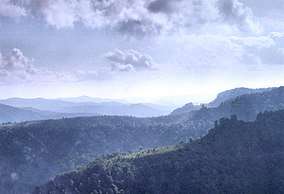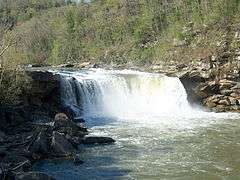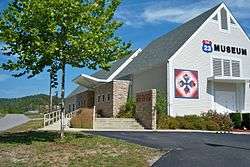Red River Gorge
The Red River Gorge is a canyon system on the Red River in east-central Kentucky. Geologically, it is part of the Pottsville Escarpment.
| Red River Gorge Geological Area | |
|---|---|
Chimney Top Rock | |
 Location of Red River Gorge in Kentucky | |
| Location | Slade, Kentucky, United States |
| Coordinates | 37°50′2″N 83°36′28″W |
| Area | 29,000 acres (120 km2)[1] |
| Established | February 1937[2] |
| Governing body | United States Forest Service |
| www | |
| Designated | 1975 |
The gorge lies within the Daniel Boone National Forest and has been subsequently designated as the Red River Gorge Geological Area, an area of around 29,000 acres (120 km2; 45 sq mi).[1] It has been designated a National Natural Landmark and National Archaeological District, and it is listed on the National Register of Historic Places.[3] The 13,379-acre (54.14 km2; 20.905 sq mi)[4] Clifty Wilderness Area lies entirely within the geological area in the Red River Gorge.
This intricate canyon system features an abundance of high sandstone cliffs, rock shelters, waterfalls, and natural bridges. There are more than 100 natural sandstone arches in the Red River Gorge Geological Area. The multitude of sandstone and cliff-lines have helped this area become one of the world's top rock climbing destinations and is home to the Red River Gorge Climbers' Coalition. The area is nicknamed the Red by climbers.[5]
Kentucky's Natural Bridge State Park is immediately adjacent to this area, featuring one of the largest natural bridges in the Red River Gorge.
The section of the Red River in the upper gorge is also a legally designated Kentucky Wild River by the Kentucky General Assembly through the Office of Kentucky Nature Preserves' Wild Rivers Program.
Because of its unusual and rugged nature, the Red River Gorge features a remarkable variety of ecological zones.

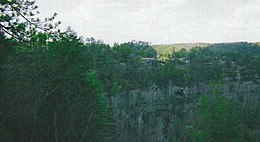
History
Nada Tunnel
Nada Tunnel is a 900-foot-long (270 m), 12-foot-wide (3.7 m), and 13-foot-high (4.0 m) logging tunnel built between 1910 and 1912. Rock and dirt were removed by dynamite, steam drills, and hand tools. One man was killed during tunnel construction when he attempted to thaw frozen dynamite which exploded when he set it near a fire.[6]
The tunnel has often been described as the "Gateway to Red River Gorge" for the shortcut it now provides motorists.[7][8]
History of the proposed Red River Gorge Dam
Decades of flooding by the Red River offered downstream residents much misery. In 1962 the "Great Flood of Clay City," the worst seen in 102 years, moved both government officials and local communities to lobby the Kentucky State Legislature and the Kennedy administration for immediate construction of a flood control dam. The United States Congress would ultimately approve the measure and provide funding. The Army Corps of Engineers set about their business of making the structure a reality; however, many felt that such actions would destroy the unique ecosystem residing there. Spearheaded by the Sierra Club, an opposition to the dam was formed. It was this group that obtained the help of Supreme Court Justice William O. Douglas by participating in a Dam Protest Hike which drew local and national attention to the situation. The Dam Protest Hike took place on November 18, 1967, at the Clifty Wilderness area, junction of Swift Camp Creek and the Red River, Highway 715.
In 1971, the University of Kentucky commissioned Wendell Berry, a Kentucky native farmer and author, to write a book entitled The Unforeseen Wilderness advocating the preservation of the gorge in its natural state.
The struggle of wills lasted several decades, involved two proposed dam sites and finally concluded with Red River's entry into the National Wild and Scenic River system on December 3, 1993. President Bill Clinton signed the declaration into law which provides federal protection for a 19.4-mile (31.2 km) section of the river. This effectively eliminated any further possibility of a dam being constructed and preserved the Red River and its Gorge as they exist today.[9]
Motion pictures
The Red River Gorge's Sky Bridge appears in the 1955 film The Kentuckian, starring and directed by Burt Lancaster.[10] It was also the first major motion picture to be filmed in Kentucky.
Biology and ecology
The Red River Gorge Geological Area, including Clifty Wilderness, has a very diverse biology. The Gorge is home to a great variety of wildlife including hawks, owls, woodpeckers, hummingbirds, deer, fox, black bears, and two venomous snakes: the copperhead and the timber rattlesnake. It is also home to several endangered species including the white-haired goldenrod which is found only in Red River Gorge. Plants of Canadian origin are believed to have been established in the Red River Gorge area during the Pliocene-Quaternary glaciation which started about 2.58 million years ago.[11] These plants are found in sheltered canyons of the area and include diverse species such as purple fringed orchid Platanthera psycodes, Canadian lily Lilium canadense, and Canadian yew Taxus canadensis.
Archaeology
Rock shelters and other sites in the Red River Gorge Geological Area contain artifacts of prehistoric occupancy by indigenous peoples, beginning with the Paleoindian period. Rock shelters are particularly valuable as archeological sites because they are protected from precipitation. Plant materials and other relics, such as woven mats and leather moccasins, that would decompose in more typical sites are well-preserved in the dry, nitrate-rich soils found in rock shelters.[3][12] Sites in the area have yielded some of the earliest evidence of the domestication of plants found in the eastern United States.[12]
The Red River Gorge, Clifty Wilderness, and the Indian Creek area were designated as a National Archaeological District and placed on the National Register of Historic Places in 2003.[3] The National Register district covers 37,217 acres (15,061 ha) of land; as of 2005, it included 29,116 acres (11,783 ha) in the national forest and 8,101 acres (3,278 ha) of private land. It contains 664 known prehistoric and historic sites that date from more than 11,000 years ago to the 20th century; 442 sites are contributing sites in the National Register district.[12]
Clifty Wilderness
Clifty Wilderness is a 13,379-acre (54.14 km2; 20.905 sq mi)[4] wilderness area contained entirely within the Red River Gorge Geological Area.
Recreation
Rock climbing
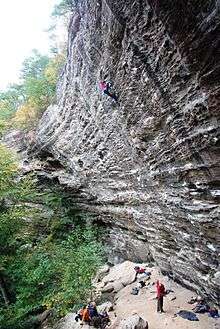

The Red River Gorge is also known as a popular destination for rock climbers, with numerous cliffs in the gorge itself and in the surrounding areas. The vast number of bolted routes in overhanging, pocketed sandstone draws climbers from all over the world to "the Red" as it is known. Climbing in the region tends to be done at large number of separate small cliffs. Most climbs are a single pitch and most cliffs are less than 200 feet (61 m) tall. There are numerous traditional and sport climbing routes in region, although the latter seems to be more dominant. Many cliffs lie within Daniel Boone National Forest; however numerous important cliffs are located on private land and in two privately owned preserves created to allow climbing access:
- Pendergrass-Murray Recreational Preserve is a 750-acre (3.0 km2) preserve owned and maintained by Red River Gorge Climbers' Coalition.
- Muir Valley is a 400-acre (1.6 km2) nature preserve and rock climbing area owned and maintained by Friends of Muir Valley thanks to a generous donation of land, labor, and resources from Rick and Liz Weber.[13]
A number of climbing guidebooks have been published for the Red River Gorge. First was Red River Gorge Climber's Guide by Frank T Becker in 1975. The explosion of climbing activity since that seminal work led to a succession of other guidebooks, including Rawk! A Climber's Guide to the Red River Gorge by Ed Benjamin and Ed Pearsall, published in 1978, Red River Gorge Climbs by John H. Bronaugh, published in 1993, and Selected Climbs at Red River Gorge Kentucky by Porter Jarrard and Chris Snyder, published in 1997. More recent published guidebooks include Ray Ellington's Red River Gorge Rock Climbs, published in 2005[14] with a second edition in 2007.[15] The continued establishment of new routes required the latest edition to the guidebook to become two volumes, Red River Gorge Climbs South[16] and Red River Gorge Climbs North.[17] Ray Ellington's newest book, Miller Fork Climbing, explores hundreds of routes in the ever-growing Miller Fork Recreational Preserve.[18]
Hiking and camping
The Red River Gorge is also known for its numerous hiking trails that range in difficulty from beginner to advanced. Over 60 miles of trails, open only to hiking, are maintained by the Forest Service and are located throughout the park (some trails are designated for horses).
Many campgrounds are located in the area. Primitive camping, also known as backpack camping, is permitted in the gorge if an overnight permit is obtained. Camping is not permitted within 300 feet of any road or designated trail. No camping in rock shelters or within 100 feet of the base of any cliff.
One of the most popular destinations is Grey's Arch, one of the many natural arches in the park. Accessible via the Grey's Arch Loop hiking trail (4.0 miles), hikers can actually scramble up the back side of the arch, although this activity is considered extremely dangerous and can lead to injury or death.[19]
Gladie Visitor Center
The Daniel Boone National Forest Gladie Visitor Center is located in the Red River Gorge in Stanton, Kentucky.[20][21] The center features interpretive exhibits about the area's geology, natural history and cultural history. Visitors can get maps, information about trails, camping and other activities.
Gallery
- Creation Falls
- Rock Bridge
 Sky Bridge
Sky Bridge Courthouse Rock
Courthouse Rock By the east entrance of the Nada Tunnel
By the east entrance of the Nada Tunnel
References
- "Red River Gorge Hiking and Camping News and Views". Retrieved 2 May 2013.
- "Daniel Boone National Forest - About the Forest". Retrieved 2 May 2013.
- "Red River Gorge Geological Area". U.S. Forest Service.
- "Wilderness Acreage Breakdown for the Clifty Wilderness".
- Pegg, Dave. Red River Gorge, Kentucky, USA, UK Climbing, March 2009.
- "Nada Tunnel on Cumberland Ranger District".
- Graybeal, Billie Sue (2008). "Nada Tunnel: The "Gateway To The Red River Gorge"". Kentucky Explorer magazine. Retrieved 2013-05-03.
- "History and heritage celebrated in Nada this weekend". The Clay City Times. June 11, 2012. Retrieved 2013-05-03.
- RRS: History of the Red River Valley Dam
- The Kentuckian, IMDB
- Mohlenbrock, Robert H (2006). This land. / A guide to eastern national forests. ISBN 978-0520930551, p. 115-116.
- "Memorandum of Agreement among the U.S. Department of Agriculture, Forest Service, the Kentucky Heritage Council, and the Advisory Council on Historic Preservation Concerning the Management of Heritage Resources and the Limits of Acceptable Change Study of the Red River Gorge National Register District on the Daniel Boone National Forest" (PDF). October 2005.
- "Muir Valley official website". Archived from the original on 14 July 2011. Retrieved 6 July 2010.
- Ellington, Ray (2005). The Red River Gorge. Wolverine. ISBN 0-9721609-4-9.
- Ellington, Ray (2007). Red River Gorge Rock Climbs (2nd ed.). Wolverine. ISBN 978-0-9792644-1-2.
- Ellington, Ray (2012). Red River Gorge Climbs South. ISBN 978-1938393044.
- Ellington, Ray (2013). Red River Gorge Climbs North. ISBN 978-1938393037.
- "Miller Fork Climbing". www.redriverclimbing.com. Retrieved 2016-05-06.
- "Gray's Arch Loop-Short (4.0 miles)". to Red River Gorge.com. 2011-02-16. Retrieved 2016-10-10.
- "Gladie Visitor Center". USDA Forest Service: Daniel Boone National Forest. Retrieved 27 September 2015.
- "Gladie Creek Historic Site, Red River Gorge". Wildlife Viewing Areas. Retrieved 27 September 2015.
External links
| Wikimedia Commons has media related to Red River Gorge. |
- KY Wilderness
- Powell County Tourism
- Search & Rescue
- The Red River Gorge Today
- Red River Gorge at American Byways
- Red River Gorge Climbers' Coalition
- Red River Gorge Geologic Area
- Red River Gorge at USDA Forest Service: Daniel Boone National Forest
- Red Wild and Scenic River at National Wild and Scenic Rivers System
- Volunteers Red River Gorge Trail Crew
